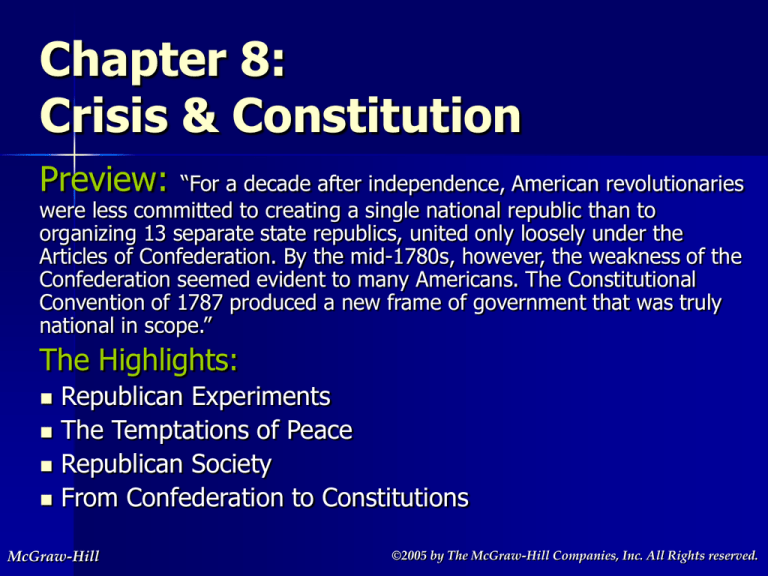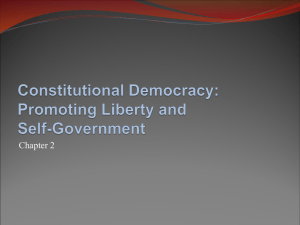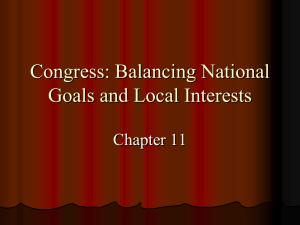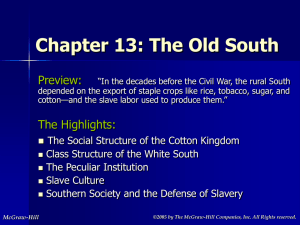
Chapter 8:
Crisis & Constitution
Preview:
“For a decade after independence, American revolutionaries
were less committed to creating a single national republic than to
organizing 13 separate state republics, united only loosely under the
Articles of Confederation. By the mid-1780s, however, the weakness of the
Confederation seemed evident to many Americans. The Constitutional
Convention of 1787 produced a new frame of government that was truly
national in scope.”
The Highlights:
Republican Experiments
The Temptations of Peace
Republican Society
From Confederation to Constitutions
McGraw-Hill
©2005 by The McGraw-Hill Companies, Inc. All Rights reserved.
Defining Republican Culture
Post-Revolutionary Divisions
–
–
McGraw-Hill
balancing individual liberty with social
order
balancing property rights with equality
Varying answers result in varying
Revolutionary governments
Revolution introduced unintended
changes into American society
©2005 by The McGraw-Hill Companies, Inc. All Rights reserved.
Social and Political Reform
McGraw-Hill
Fundamental questions raised about
the meaning of equality
Changes in laws of inheritance
More liberal voting qualifications
Better representation for frontier
settlers
Separation of church and state
Hierarchical social relations challenged
©2005 by The McGraw-Hill Companies, Inc. All Rights reserved.
Slavery and Sectionalism
– 1775: African Americans were 20% of nation’s
population; 90% of them lived in the South
– Difficulty of squaring republican ideals with the
continued presence of slavery
– Most northern states began to abolish slavery
– Southerners debate abolition
– some privately free slaves
– economic motives overcome republican ideals
– Free black population grew in both the North
and South
– Slavery continued to exist in southern states
African Americans embrace Declaration’s
stress on natural rights
McGraw-Hill
©2005 by The McGraw-Hill Companies, Inc. All Rights reserved.
The Challenge of Women's
Rights
McGraw-Hill
Women demand the natural right of
equality
Contribute to new society through
“Republican Motherhood”
Women more assertive in divorce,
economic life
Denied political and legal rights
©2005 by The McGraw-Hill Companies, Inc. All Rights reserved.
Postponing Full Liberty
McGraw-Hill
Revolution limited in extension of
rights
Introduced ideal of freedom and
equality
Future generations would make these
ideals reality
©2005 by The McGraw-Hill Companies, Inc. All Rights reserved.
Republican Experiments
The State Constitutions
– Desire to curb executive power
– Strengthened legislative powers
The people demand written constitutions
– provide clear definition of rights
– describe clear limits of government
– Written constitutions seen as legal codes to
protect the people
From Congress to Confederation
– Articles of Confederation created a weak
government that consisted only of a national
legislature
McGraw-Hill
©2005 by The McGraw-Hill Companies, Inc. All Rights reserved.
The States: Experiments in
Republicanism
McGraw-Hill
Revolutionary state constitutions serve
as experiments in republican
government
Insights gleaned from state
experiences later applied to
constructing central government
©2005 by The McGraw-Hill Companies, Inc. All Rights reserved.
Blueprints for State Government
McGraw-Hill
State constitution writers insist on
preparing written documents
Precedents in colonial charters, church
covenants
Major break with England’s unwritten
constitution
©2005 by The McGraw-Hill Companies, Inc. All Rights reserved.
Natural Rights and the State
Constitutions
State constitutions guarantee major rights
–
–
–
–
freedom of religion
freedom of speech
freedom of the press
private property
Governors weakened
Elected assemblies given most power
McGraw-Hill
©2005 by The McGraw-Hill Companies, Inc. All Rights reserved.
Power to the People
Procedure for adoption of Constitution
pioneered by Massachusetts
–
–
McGraw-Hill
Constitution written by a special
convention
ratification by referendum of the people
State constitutions seen as flawed
experiments
Growing sentiment for stronger central
government
©2005 by The McGraw-Hill Companies, Inc. All Rights reserved.
Articles of Confederation
John Dickinson’s plan for central
government
–
–
proposed cession of West to Congress
opposed
proposed equality in state representation
opposed
Articles of Confederation severely limit
central government’s authority over states
States suspicious of Articles
McGraw-Hill
©2005 by The McGraw-Hill Companies, Inc. All Rights reserved.
Western Land:
Key to the First Constitution
Maryland ratification of Articles
delayed for Virginia’s renunciation of
Western claims
1781--Virginia takes lead in ceding
Western claims to Congress
Other states cede claims to Congress
Congress gains ownership of all land
west of Appalachians
McGraw-Hill
©2005 by The McGraw-Hill Companies, Inc. All Rights reserved.
The Temptations of Peace
The Temptations of the West
– Greatest opportunities existed in the West,
but the region was beset with intense conflict
Foreign Intrigues
– Continued efforts by the British to harass
American interests in the Old Northwest
– Spanish designs on the Old Southwest
– Indians played pivotal roles in both regions
McGraw-Hill
©2005 by The McGraw-Hill Companies, Inc. All Rights reserved.
Disputes among the States
– Tensions between “landed” and “landless”
states
– Dispute resolved, and the Articles of
Confederation ratified in 1781
The More Democratic West
– State legislatures became more
democratic as a result of population
growth in the backcountry
McGraw-Hill
©2005 by The McGraw-Hill Companies, Inc. All Rights reserved.
Western Land Claims Ceded by
the States
McGraw-Hill
©2005 by The McGraw-Hill Companies, Inc. All Rights reserved.
The Northwest Territory
– Congress adopted three ordinances in the
1780s to deal with issue of westward
expansion
– The most important was the Northwest
Ordinance of 1787, which outlawed
slavery north of the Ohio River
“By limiting the spread of slavery in the northern states,
Congress deepened the critical social and economic
differences between North and South, evident already in
the 1780s”(206).
McGraw-Hill
©2005 by The McGraw-Hill Companies, Inc. All Rights reserved.
Northwest Ordinance: The
Confederation's Major Achievement
McGraw-Hill
Creates 3-5 new territories in
Northwest
Population of 5,000 may elect
Assembly
Population of 60,000 may petition for
statehood
Bill of Rights provided
Slavery outlawed
©2005 by The McGraw-Hill Companies, Inc. All Rights reserved.
Northwest Territory
McGraw-Hill
©2005 by The McGraw-Hill Companies, Inc. All Rights reserved.
Land Ordinance of 1785
McGraw-Hill
©2005 by The McGraw-Hill Companies, Inc. All Rights reserved.
Wartime Economic Disruption
– Postwar consumption produced massive
public and private debt
– Reckless printing of paper money and
shortage of goods sparked severe inflation
– Serious conflicts over economic policy
“So long as the individual states remained sovereign, the
Confederation was crippled—unable to conduct foreign affairs
effectively, unable to set coherent economic policy, unable to
deal with discontent in the West”(208-9).
McGraw-Hill
©2005 by The McGraw-Hill Companies, Inc. All Rights reserved.
The Nationalist Critique
Congress unable to address inflation, debt
Congress has no power to tax
Inadequate authority over interstate
affairs
Inadequate influence on national
economy
Weak foreign policy- British troops still on
American soil
Failure of reform prompts Nationalists to
consider Articles hopelessly defective
McGraw-Hill
©2005 by The McGraw-Hill Companies, Inc. All Rights reserved.
Diplomatic Humiliation
The Jay-Gardoqui Treaty
– John Jay to negotiate reopening Mississippi
instead signs treaty favoring Northeast:
– Spain closes New Orleans to American
commerce in 1784
– Sectional animosity aggravated by proposed—
but never ratified—treaty between the United
States and Spain over shipping rights on the
Mississippi River.
– West and South denounce, Congress rejects
Jay-Gardoqui Treaty
McGraw-Hill
©2005 by The McGraw-Hill Companies, Inc. All Rights reserved.
The Genius of James Madison
McGraw-Hill
Recognition by 1780s of shortcomings
in small state republics
Stronger central government gains
support
James Madison persuades Americans
that large republics could be free and
democratic
©2005 by The McGraw-Hill Companies, Inc. All Rights reserved.
McGraw-Hill
©2005 by The McGraw-Hill Companies, Inc. All Rights reserved.
Constitutional Reform
McGraw-Hill
May 1786--Annapolis Convention
agrees to meet again, write a new
constitution
Summer 1786--Shay’s Rebellion sparks
fears of national dissolution
Crisis strengthens support for new
central government
©2005 by The McGraw-Hill Companies, Inc. All Rights reserved.
The Philadelphia Convention
McGraw-Hill
Convenes May 1787
55 delegates from all states except
Rhode Island
Delegates possess wide practical
experience
©2005 by The McGraw-Hill Companies, Inc. All Rights reserved.
Framing a Federal Constitution
– May 1787: delegates from the states met in
Philadelphia “for the express purpose of
revising the Articles of Confederation”
– James Madison became a key figure in the
proposed overhaul of the government
The Virginia and New Jersey Plans
– Madison’s Virginia Plan: three-branch
government; Congress could veto state
legislation
– Paterson’s New Jersey Plan: a weaker central
government than Madison’s plan provided for
– Deadlock between the plans
McGraw-Hill
©2005 by The McGraw-Hill Companies, Inc. All Rights reserved.
Inventing a Federal Republic:
The Virginia Plan
Central government may veto all state acts
Bicameral legislature of state representatives
Larger states have more representatives
Chief executive appointed by Congress
Small states object to large-state dominance
McGraw-Hill
©2005 by The McGraw-Hill Companies, Inc. All Rights reserved.
Inventing a Federal Republic: The
New Jersey Plan
Congress given greater taxing powers
Each state would have one vote in a
unicameral legislature
Articles of Confederation otherwise
untouched
McGraw-Hill
©2005 by The McGraw-Hill Companies, Inc. All Rights reserved.
Compromise Saves the Convention
The Great Compromise:
-Each state given two delegates in the
Senate--a victory for the small states
-House of Representatives based on
population--a victory for the large states
The 3/5 Compromise:
-Three-fifths of the slave population
counted toward representation in the
House
McGraw-Hill
©2005 by The McGraw-Hill Companies, Inc. All Rights reserved.
Compromising with Slavery
Issue of slavery threatens Convention’s
unity
–
–
Northerners tend to be opposed
Southerners threaten to bolt if slavery
weakened
Slave trade permitted to continue to 1808
“Great as the evil is, a dismemberment of
the Union would be worse.”
--James Madison
McGraw-Hill
©2005 by The McGraw-Hill Companies, Inc. All Rights reserved.
The Last Details
July 26—Committee of Detail formed to
prepare rough draft
Revisions to Executive
– Electoral College ensures president will not be
indebted to Congress
– executive given a veto over legislation
– executive may appoint judges
Decision that Bill of Rights unnecessary
– Possibility to amend the Constitution
McGraw-Hill
©2005 by The McGraw-Hill Companies, Inc. All Rights reserved.
We, the People
McGraw-Hill
Convention seeks to bypass vested
interests of state legislatures
Power of ratification to special state
conventions
Constitution to go into effect on
approval by nine state conventions
Phrase “We the People” makes
Constitution a government of the
people, not the states
©2005 by The McGraw-Hill Companies, Inc. All Rights reserved.
Whose Constitution?
Struggle for Ratification
Supporters recognized the Constitution went
beyond the Convention’s mandate
Document referred to states with no
recommendation
– Anti-Federalists opposed to Constitution because of
perceived power it gave to aristocrats and the
central government
– Federalists Madison, Hamilton, and Jay wrote The
Federalist Papers to counter concerns; Madison also
promised a Bill of Rights
McGraw-Hill
©2005 by The McGraw-Hill Companies, Inc. All Rights reserved.
Federalists
McGraw-Hill
Led by James Madison and Alexander
Hamilton
Supported the Constitution
Well-organized
Supported by most of the news media
©2005 by The McGraw-Hill Companies, Inc. All Rights reserved.
Anti-Federalists
Major leaders included Patrick Henry of
Virginia and Governor George Clinton of
New York
Opposed to the Constitution
Believed Constitution robbed the states of
too much power
Distrusted any government removed from
direct control of the people
Suspected the new Constitution favored
the rich and powerful
Demanded a Bill of Rights
McGraw-Hill
©2005 by The McGraw-Hill Companies, Inc. All Rights reserved.
Adding the Bill of Rights
McGraw-Hill
The fruit of Anti-Federalist activism
Nationalists promise to add a bill of
rights
First ten amendments added by
December 1791
©2005 by The McGraw-Hill Companies, Inc. All Rights reserved.
Bill of Rights
McGraw-Hill
First 10 Amendments
to the Constitution
Major freedoms listed:
speech, press,
religion, right to bear
arms, fair trial, search
warrants, states rights
©2005 by The McGraw-Hill Companies, Inc. All Rights reserved.
Progress of Ratification
McGraw-Hill
Succeed in winning ratification in 11
states by June 1788
North Carolina ratifies November 1789
Rhode Island ratifies May 1790
Americans close ranks behind the
Constitution
©2005 by The McGraw-Hill Companies, Inc. All Rights reserved.
Ratification of the Constitution
McGraw-Hill
©2005 by The McGraw-Hill Companies, Inc. All Rights reserved.
McGraw-Hill
©2005 by The McGraw-Hill Companies, Inc. All Rights reserved.
McGraw-Hill
©2005 by The McGraw-Hill Companies, Inc. All Rights reserved.
“Within the life span of a single generation, Americans had declared
their independence twice. In many ways the political freedom
claimed from Britain in 1776 was less remarkable than the
intellectual freedom that Americans achieved by agreeing to the
Constitution”(220).
Changing Revolutionary Ideals
– Americans rejected some republican
beliefs by agreeing to a sovereign
national government and an independent
executive
– Behavior shaped by interest rather than
virtue
– Constitutional debates would evolve into
subsequent political tensions
McGraw-Hill
©2005 by The McGraw-Hill Companies, Inc. All Rights reserved.










